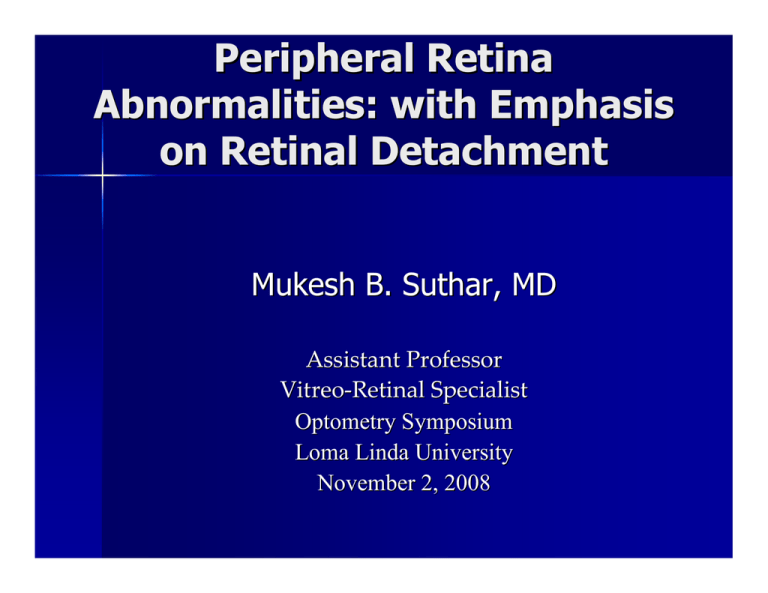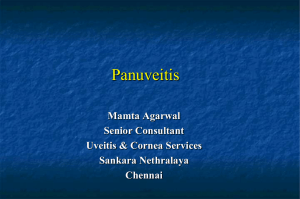Peripheral Retina Abnormalities - Loma Linda University Medical
advertisement

Peripheral Retina Abnormalities: with Emphasis on Retinal Detachment Mukesh B. Suthar, MD Assistant Professor Vitreo‐Retinal Specialist Optometry Symposium Loma Linda University November 2, 2008 Retinal Anatomy The Peripheral Retina Long Ciliary artery and nerve Vortex veins Ora Serrata Pars Plana Pars Plicata The Peripheral Retina Long Ciliary artery and nerve Vortex veins Divides Fundus into Posterior and Peripheral Retina Anatomical equator is 3mm anterior to entrance Ora Serrata Pars Plana Pars Plicata The Peripheral Retina Long Ciliary artery and nerve Vortex veins Ora Serrata Pars Plana Pars Plicata Ora Serrata Ora Serrata Region – More pronounced dentate processes nasally – 3DD wide, 1DD anteriorly, 2DD posteriorly – Sensory retina -> nonpigmented ciliary epithelium Pars Plana Pars Plicata Ora Serrata Ora Serrata Region Pars Plana – Asymmetrical (wider temporally) – Average 4mm width (from ora serrata to ciliary crest) – Entrance for Vitrectomy Pars Plicata Ora Serrata Ora Serrata Region Pars Plana Pars Plicata – contains 73 ciliary processes – Production of aqueous humor – Ciliary muscles Vitreous Vitreous Base Extends 1.5 mm anteriorly Extends 1.8 temporally, and 3 mm nasally posteriorly to ora serrata Firm attachment of: – Sensory retina – RPE – Vitreous Base Consists of 99% water, +hyaluronic acid, salts, collagen fibrils, proteins Examination Indirect Ophthalmoscopy ¾ Three mirror contact lens ¾ Wide angle contact lens ¾ Transillumination ¾ Indirect Ophthalmoscopy • • • • • Steropsis Less distortion Better visualization in eyes with hazy view Wide field of view Readily perform scleral depression Three Mirror Contact Lens • • • • Excellent visualization Readily view ora serrata and pars plana Good visualization of overlying vitreous Limited field of view Wide Angle Contact Lens Excellent field of view Distortion in periphery Poor depth perception Low resolution Peripheral Retina: Retinal Detachment Seperation between sensory retina and retinal pigment epithelium Four types: – – – – Rhegmatogenous Exudative Tractional Complex Peripheral Retina: Retinal Detachment Seperation between sensory retina and retinal pigment epithelium Four types: – – – – Rhegmatogenous Exudative Tractional Complex Peripheral Retina: Retinal Detachment Seperation between sensory retina and retinal pigment epithelium Four types: – – – – Rhegmatogenous Exudative Tractional Complex Peripheral Retina: Retinal Detachment Seperation between sensory retina and retinal pigment epithelium Four types: – – – – Rhegmatogenous Exudative Tractional Complex Rhegmatogenous Retinal Detachment 1. 2. 3. 4. Retinal break Hydrostatic forces Liquefied vitreous Traction * University of Toronto Schema (Break-Fluid-Fluid-Traction) Rhegmatogenous Retinal Detachment 1. Retinal break rhegma = break often caused by PVD 2. 3. 4. Hydrostatic forces Liquefied vitreous Traction) Rhegmatogenous Retinal Detachment 1. 2. Retinal break Hydrostatic forces RPE pump, intraocular pressure, osmotic pressure) 3. 4. Liquefied vitreous Traction Rhegmatogenous Retinal Detachment Retinal break Hydrostatic forces Liquefied vitreous 1. 2. 3. • • 4. Offers access point Enters through break Traction Rhegmatogenous Retinal Detachment Retinal break Hydrostatic forces Liquefied vitreous Traction 1. 2. 3. 4. • • Mechanical forces Ocular saccades RRD: Incidence Rate approximately 1 in 10,000 / year Lifetime estimated, at 0.06 % Incidence of Retinal Breaks is 3.3 % /year – => so, risk of RD is 1:330 Common age range 40-70 years old RRD: Findings Tear found in 97% of the cases 10% from asymptomatic retinal break 50% have floaters or photopsia + Shafer’s sign (tobacco dust) Lowered IOP Corrugated retinal folding RRD: Common Risk Factors Myopia Aphakia Trauma RD in fellow eye (15%) Family history of RD Peripheral Lesions Systemic (Goldmann-Favre, Stickler’s) RRD: Common Risk Factors Myopia – 1-3D, risk 4x population – > 3D, risk 10x population Aphakia Trauma RD in fellow eye Family history of RD Peripheral Lesions Systemic (Goldmann-Favre, Stickler’s) RD: after Cataract Extraction Surgical complications increase risk • Norregaard, BJO 1996 RRD: Prevention Recognition of acute PVD signs Assess Risk Factors Identify peripheral pathology Treatment of “high risk” tears Patient Education RRD: Prevention Recognition of acute PVD signs Assess Risk Factors Identify peripheral pathology Treatment of “high risk” tears Patient Education RRD: Prevention Recognition of acute PVD signs Assess Risk Factors Identify peripheral pathology Treatment of “high risk” tears Patient Education RRD: Prevention Recognition of acute PVD signs Assess Risk Factors Identify peripheral pathology Treatment of “high risk” tears Patient Education RRD: Prevention Recognition of acute PVD signs Assess Risk Factors Identify peripheral pathology Treatment of “high risk” tears Patient Education Vitreous Posterior vitreous detachment (PVD) – Vitreous liqufeaction (syneresis) – Firm attachment at vitreous base, optic nerve, paravascular Vitreous - PVD Posterior vitreous detachment (PVD) – Seperation from Optic Nerve. – If other locations, consider another mechanism (eg. Inflammatory) PVD Symptoms Flashes – Caused by vitreous traction – Not location specific Floaters – – – – Single spot Strands Cobweb Sand storm Visual Field Loss = RD PVD Prevalence associated with: – Age (63% at 70 yo) – Axial length / Myopia – Aphakia – Pseudophakia / Vitreous Loss – Inflammatory Disease – Trauma PVD - importance PVD + Retinal Break 10-15% with acute symptoms have retinal break(s) – New retinal break found in 2%, esp if hemorrhage, or, new symptoms – Development of RD unlikely if no retinal tears found in 4-6 weeks 50-70% with acute symptoms and vitreous hemorrhage have retinal breaks – Avulsion of overlying vessel – Paripapillary vessel PVD + Retinal Break 10-15% with acute symptoms have retinal break(s) – New retinal break found in 2%, esp if hemorrhage, or, new symptoms – Development of RD unlikely if no retinal tears found in 4-6 weeks 50-70% with acute symptoms and vitreous hemorrhage have retinal breaks – Avulsion of overlying vessel – Paripapillary vessel Which Retinal Breaks to Treat? Retinal Dialysis Horshoe tears Operculated Hole – Symptomatic – Asymptomatic Atrophic hole Lattice degeneration Always Always Sometimes Rarely Rarely Rarely * Modified AAO, Preferred Practice Pattern, 2003 Lesions not predisposing to RD Cobblestone degeneration Peripheral cystoid degeneration White with/without pressure RPE Hyperplasia RPE Hypertophy Pars plana cysts • From Dr. H. Riley / Indiana University Lesions not predisposing to RD Cobblestone degeneration – Multiple, round, area of choroidal, retinal atrophy – Often bilateral Peripheral cystoid degeneration White with/without pressure RPE Hyperplasia RPE Hypertophy Pars plana cysts White Without Pressure Lesions predisposing to RD Lattice degeneration Cystic retinal tuft Meridonal folds Enclosed ora bays Degenerative Retinoschisis Lesions predisposing to RD Lattice degeneration Cystic retinal tuft Meridonal folds Enclosed ora bays Degenerative Retinoschisis Lattice Degeneration Found in 8% of the population, bilateral in 45% Risk to RD in 5% ; with Myopia ~ 25% Often in myopia, familial pattern 30% of patients with RD have lattice Lattice Degeneration Often found midway between ora serrata and the equator Circumferential area with criss-crossing white lattice lines (hyalinized blood vessels) – Perivascular and radial (eg. Stickler’s syndrome) Lattice Degeneration No ILM (#1); retinal thinning ; overlying vitreous liquefaction (#3); adherence at borders (#4) Lesions predisposing to RD Lattice degeneration – Risk to RD ~ <1% Cystic retinal tuft – Round elevation, glial tissue – 5% in autopsy, bilateral in 20% – Risk to RD ~ 0.28% Meridonal folds Enclosed ora bays Lesions predisposing to RD Lattice degeneration – Risk to RD ~ <1% Cystic retinal tuft Meridonal folds – Redundant fold of retina to pars plicata processes – May have associated posterior break – Superior nasal common Enclosed ora bays Retinal Breaks Horseshoe tear Operculated Hole Atrophic Hole Giant Retinal Tear Macular hole Dialyses Retinal Breaks Horseshoe tear Operculated Hole Atrophic Hole Giant Retinal Tear Macular hole Dialyses Retinal Breaks Horseshoe tear Operculated Hole Atrophic Hole Giant Retinal Tear Macular hole Dialyses Retinal Breaks Horseshoe tear Operculated Hole Atrophic Hole Giant Retinal Tear Macular hole Dialyses Retinal Breaks Horseshoe tear Operculated Hole Atrophic Hole Giant Retinal Tear Macular hole Dialyses Retinal Breaks Horseshoe tear Operculated Hole Atrophic Hole Giant Retinal Tear Macular hole Dialyses Retinal Breaks Horseshoe tear Operculated Hole Atrophic Hole Giant Retinal Tear Macular hole Dialyses – Full thickness disinsertion at the ora serrata – Often associated with blunt trauma Treatment of Retinal Breaks 30-50% of symptomatic horseshoe tears result in RD, – => vs those treated to 5% Follow up closely, since new retinal breaks occur in 8% Treatment: Laser Retinopexy Applied either with Indirect Ophthalmoscope, or Contact Lens 5-7 days for adhesion nu4 Slide 60 nu4 scar forms in 5-7 days new user, 10/26/2008 Differential Diagnosis of Retinal Detachment Retinoschisis Vitreous Hemorrhage Choroidal Lesions – Choroidal Detachment – Choroidal Melanoma Retinoschisis Differential Diagnosis of Retinal Detachment Retinoschisis Vitreous Hemorrhage Choroidal Lesions – Choroidal Detachment – Choroidal Melanoma Repair of Retinal Detachment Basically five options: – Retinopexy (Laser or Cryotherapy) – Pneumatic Retinopexy – Balloon – Scleral Buckle – Pars Plana Vitrectomy Success approaches 90-95% Repair of Retinal Detachment Basically five options: – Retinopexy (Laser or Cryotherapy) – Pneumatic Retinopexy – Balloon – Scleral Buckle – Pars Plana Vitrectomy Success approaches 90-95% Retinal Detachment: Macular Status Visual prognosis good if macula on (87%>20/50) Prognosis guarded if macula off (50%>20/50) Prognosis related to macula off duration (??, age) Retinal Detachment: Duration Pnematic Retinopexy Limited to Superior detachments Positioning requirement Scleral Buckle Indents eye from outside to reappose retina Need to be able to visualize all breaks Variations: – +/- Drainage – Encircling vs. Radial Band Pars Plana Vitrectomy Versatile Various gauges: 20g, 23g, and 25g Pars Plana Vitrectomy Versatile Various gauges: 20g, 23g, and 25g Giant Retinal tear Defined as greater than 3clock hours Bilateral GRT especially in high myopes, Stickler’s syndrome Replacements Fluid Air Gas: SF6, C3F8 Silicon Oil Peripheral Retina Summary Anatomy Examination Retinal Detachment – – – – – Types Vitreous Retinal Breaks Risk Factors Introduction to RD Repair Peripheral Retina Summary Anatomy Examination Retinal Detachment – – – – – Types Vitreous Retinal Breaks Risk Lesions Introduction to RD Repair Peripheral Retina Summary Anatomy Examination Retinal Detachment – – – – – Types Vitreous Retinal Breaks Risk Lesions Introduction to RD Repair Peripheral Retina Summary Anatomy Examination Retinal Detachment – – – – – Types Vitreous Retinal Breaks Risk Lesions Introduction to RD Repair Peripheral Retina Summary Anatomy Examination Retinal Detachment – – – – – Types Vitreous Retinal Breaks Risk Lesions Introduction to RD Repair Peripheral Retina Summary Anatomy Examination Retinal Detachment – – – – – Types Vitreous Retinal Breaks Risk Lesions Introduction to RD Repair Peripheral Retina Summary Anatomy Examination Retinal Detachment – – – – – Types Vitreous Retinal Breaks Risk Lesions Introduction to RD Repair Peripheral Retina Thank You!




